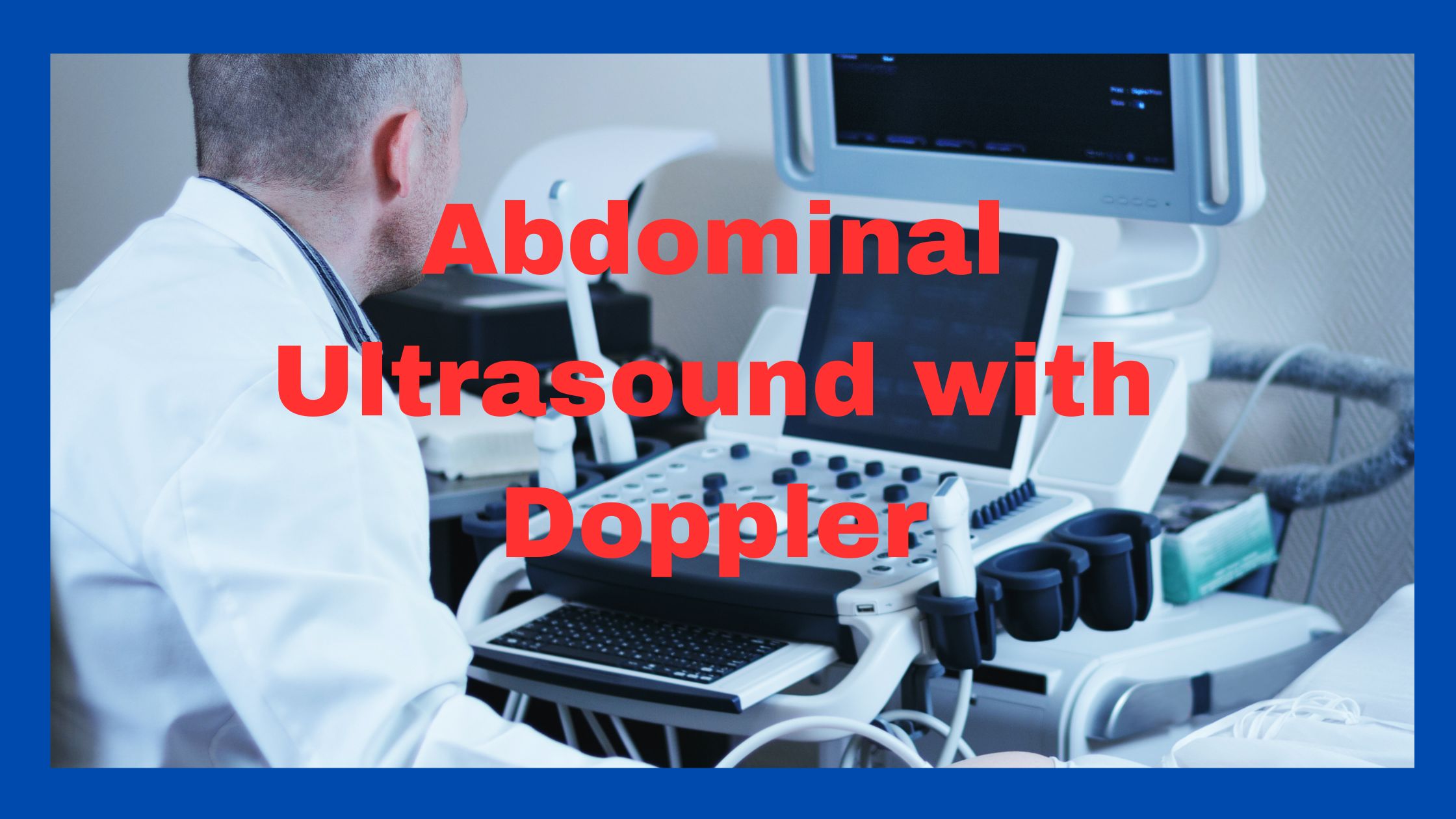In medical imaging, abdominal ultrasound with Doppler is a important tool for diagnosing and evaluating various conditions. CPT Code 76700 refers explicitly to the procedure used to capture images of the abdominal organs and blood vessels using ultrasound technology.
This non-invasive and painless test provides essential information for physicians to assess organ health, detect abnormalities, and aid in diagnosing and treating numerous medical conditions.
What is Abdominal Ultrasound with Doppler?
Abdominal ultrasound with Doppler is a specialized imaging technique that combines traditional ultrasound imaging with Doppler technology. Doppler ultrasound measures the speed and direction of blood flow within the vessels, allowing for the assessment of blood flow abnormalities, such as blockages or obstructions.
The Procedure:
During an abdominal ultrasound with Doppler, a trained sonographer or radiologist will apply a gel to the patient’s abdomen to facilitate sound wave transmission. They will then use a handheld device called a transducer, which emits high-frequency sound waves that bounce off the organs and blood vessels in the abdominal region.
The transducer also contains a Doppler component that detects the frequency shift of the sound waves as they interact with moving blood cells.
Also Read : List of CPT Codes in Medical Billing | CPT Code Lookup
Uses of CPT Code 76700:
1. Assessing the Abdominal Organs:
CPT Code 76700 allows healthcare professionals to evaluate the condition and function of various abdominal organs, including the liver, gallbladder, pancreas, spleen, kidneys, and bladder. This procedure can help detect abnormalities such as tumors, cysts, gallstones, kidney stones, and liver diseases.
Additionally, by assessing these organs’ size, shape, and texture, abdominal ultrasound with Doppler can provide valuable information about their overall health and functioning.
2. Evaluating Blood Flow:
The Doppler component of the procedure enables the assessment of blood flow within the abdominal blood vessels. It provides information about arterial or venous obstructions, blood clots, aneurysms, and other vascular abnormalities.
By evaluating the blood flow, healthcare professionals can diagnose and monitor conditions such as deep vein thrombosis, peripheral artery disease, and portal hypertension.
key Points About CPT code 76700:
- CPT code 76700 is for ultrasound of the abdomen. It is used to report a complete ultrasound examination of the abdomen.
- This code covers imaging of the liver, gallbladder, pancreas, kidneys, aorta, inferior vena cava, portal vein, spleen, and any other structures visible with ultrasound in the abdomen.
- It does not include imaging of the retroperitoneum or abdominal wall. Separate codes exist for those areas if needed.
- 76700 is used to report an ultrasound done for a variety of reasons – screening, evaluation of known or suspected abnormalities, follow up of previous findings, etc.
- It is typically billed as one unit of service, regardless of how long the ultrasound takes. Add-on codes may be reported in addition to 76700 if certain additional/detailed evaluations are performed.
- Use of contrast is not included in 76700. If intravenous ultrasound contrast is used, 76775 can be reported in addition.
- The code description for 76700 is simply “Us exam abdomen complete.” Complete refers to imaging of the entire abdominal cavity.
- 76700 is a bilateral procedure and should not be reported twice to indicate bilaterality.
- It is typically reported by radiologists, radiology departments, and some specialists like gastroenterologists who perform abdominal ultrasound studies.
Advantages of Abdominal Ultrasound with Doppler:
1. Non-Invasive and Painless:
One of the significant advantages of abdominal ultrasound with Doppler is that it does not involve surgical incisions or radiation exposure. It is a safe, non-invasive, and painless procedure for patients of all ages.
This non-invasive nature of the procedure makes it particularly suitable for pediatric patients and individuals who may be unable to undergo more invasive imaging techniques. It also eliminates the risks associated with radiation exposure, providing patients and healthcare professionals peace of mind.
2. Real-Time Imaging:
The real-time imaging capabilities of abdominal ultrasound with Doppler allow for immediate visualization of the organs and blood flow. This prompt visualization is invaluable in diagnosing potential issues, as it enables healthcare professionals to assess the situation quickly and develop treatment plans accordingly.
By providing real-time images and waveforms, abdominal ultrasound with Doppler offers a dynamic view of the abdominal region. This dynamic view allows healthcare professionals to assess organ function, blood flow patterns, and abnormalities in real time, leading to faster and more accurate diagnoses.
3. Cost-Effective:
Compared to other imaging modalities, abdominal ultrasound with Doppler is generally more cost-effective. It does not require expensive equipment or contrast agents, making it an accessible option for patients and healthcare facilities.
The cost-effectiveness of this procedure allows for more widespread availability and affordability, ensuring that patients receive the necessary diagnostic services without undue financial burden. The absence of contrast agents also eliminates the associated risks and potential side effects, contributing to the overall cost-effectiveness of abdominal ultrasound with Doppler.
Also Lookup : Complete List of Radiology CPT Codes
What is CPT code 76700 and 93975?
CPT Code 76700:
- Description: CPT code 76700 represents a complete abdominal ultrasound examination. This diagnostic procedure uses high-frequency sound waves to create images of the abdominal organs and structures, including the liver, gallbladder, pancreas, spleen, kidneys, and major blood vessels (aorta and vena cava). It is a non-invasive imaging technique used to assess the health and condition of these abdominal structures.
- Clinical Indications: Abdominal ultrasound is commonly used to diagnose and monitor various medical conditions affecting the abdominal area, such as liver disease, gallstones, kidney stones, abdominal masses, abdominal pain, and vascular issues.
- Procedure: During an abdominal ultrasound, a transducer is moved over the patient’s skin after applying a gel to the abdominal area. The transducer emits sound waves that create images of the internal organs.
CPT Code 93975:
- Description: CPT code 93975 represents a duplex scan of arterial inflow and venous outflow of abdominal, pelvic, scrotal, or retroperitoneal organs; this is often called a “duplex ultrasound.” It is used to evaluate the blood flow in the arteries and veins of the abdominal, pelvic, scrotal, or retroperitoneal regions.
- Clinical Indications: Duplex ultrasound is primarily used to assess blood flow and detect arterial stenosis or occlusion, venous thrombosis, aneurysms, and vascular malformations in the specified areas.
- Procedure: The duplex scan combines traditional ultrasound imaging with Doppler ultrasound, which measures blood flow velocity and direction. This allows healthcare providers to assess the blood vessels’ structure and function in the areas mentioned in the code.
CPT codes 76700 and 93975 are used in medical billing to describe different ultrasound examinations. Code 76700 is specific to abdominal ultrasound and focuses on imaging abdominal organs and structures. In contrast, code 93975 relates to a duplex ultrasound that assesses blood flow in particular regions, such as the abdomen, pelvis, scrotum, or retroperitoneal organs.
Conclusion:
CPT Code 76700 for abdominal ultrasound with Doppler is a crucial diagnostic tool in modern medicine. It provides valuable insights into the condition of abdominal organs and blood vessels, aiding in diagnosing and treating various medical conditions. This non-invasive and painless procedure offers real-time imaging and is cost-effective compared to other imaging modalities.
With proper preparation and skilled operators, abdominal ultrasound with Doppler has become an indispensable tool for healthcare professionals, allowing them to provide accurate and timely patient care.
Related Articles:
The author and contributor of this blog "NSingh" is working in Medical Billing and Coding since 2010. He is MBA in marketing and Having vaste experience in different scopes of Medical Billing and Coding as AR-Follow-up, Payment Posting, Charge posting, Coding, etc.

